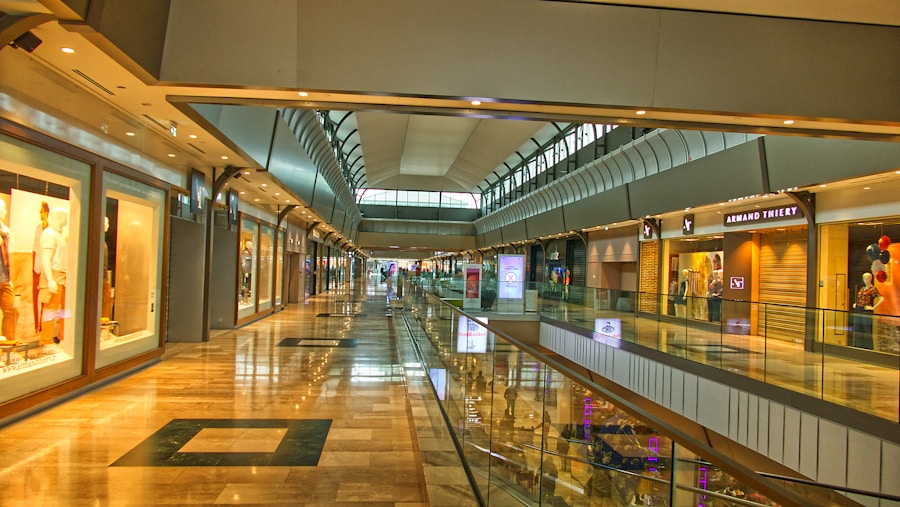Shopping malls have undergone a remarkable transformation since their inception in the mid-20th century. The concept of the shopping mall emerged in the United States during the 1950s, a time when suburbanization was on the rise, and consumer culture was flourishing. The first fully enclosed shopping mall, Southdale Center, opened in Edina, Minnesota, in 1956, setting a precedent for future developments.
These malls became social hubs, offering not just retail options but also dining, entertainment, and leisure activities. The architecture of these spaces often featured expansive atriums, skylights, and a variety of stores that catered to diverse consumer needs. As the economy boomed in the 1980s and 1990s, malls proliferated across the country, becoming symbols of affluence and modernity.
However, the turn of the millennium marked a significant shift in the retail landscape. The rise of e-commerce began to challenge the traditional mall model, as consumers increasingly favored the convenience of online shopping. By the late 2000s, many malls faced declining foot traffic and store closures.
The Great Recession further exacerbated these issues, leading to a wave of bankruptcies among major retailers. Iconic malls that once thrived became ghost towns, with empty storefronts and dwindling customer bases. This decline prompted a reevaluation of the mall’s role in society and its ability to adapt to changing consumer preferences.
Key Takeaways
- Shopping malls have evolved from being the go-to destination for shopping and socializing to facing challenges and decline in recent years.
- Shopping malls are embracing technology by incorporating digital tools and online platforms to enhance the shopping experience and attract customers.
- The rise of experiential retail is transforming shopping malls into destinations that offer unique and memorable experiences beyond traditional shopping.
- Shopping malls are increasingly adopting sustainability and green initiatives to reduce their environmental impact and attract environmentally conscious consumers.
- Community spaces within shopping malls are being reimagined to create gathering places that offer entertainment, events, and social experiences for visitors.
Embracing Technology: How Shopping Malls Are Adapting to the Digital Age
In response to the challenges posed by e-commerce, shopping malls have begun to embrace technology as a means of revitalization. Many malls are integrating digital tools to enhance the shopping experience and attract tech-savvy consumers. For instance, interactive kiosks and mobile apps are becoming commonplace, allowing shoppers to navigate stores more efficiently and access real-time information about promotions and events.
Some malls have even implemented augmented reality (AR) features that enable customers to visualize products in their own homes before making a purchase. This fusion of technology with traditional retail not only enhances convenience but also creates a more engaging shopping environment. Moreover, shopping malls are leveraging data analytics to better understand consumer behavior and preferences.
By analyzing foot traffic patterns and purchasing trends, mall operators can tailor their offerings to meet the demands of their clientele. For example, if data indicates that a particular demographic frequents a mall during specific hours, management can adjust store hours or host targeted events to draw in those shoppers. Additionally, many malls are investing in high-speed Wi-Fi and charging stations to cater to the needs of mobile users, ensuring that visitors remain connected while they shop.
This technological evolution is not merely about keeping pace with e-commerce; it is about creating a seamless integration of online and offline shopping experiences.
The Rise of Experiential Retail: Creating Unique and Memorable Shopping Experiences

As competition from online retailers intensifies, shopping malls are increasingly focusing on experiential retail—creating unique and memorable experiences that cannot be replicated online. This trend recognizes that consumers are seeking more than just products; they desire experiences that engage their senses and foster emotional connections. Malls are responding by incorporating entertainment options such as live performances, art installations, and interactive exhibits that draw visitors in and encourage them to linger longer.
For instance, some malls have introduced themed pop-up shops that change regularly, offering limited-time products and experiences that entice shoppers to return frequently. These pop-ups often feature collaborations with local artists or brands, creating a sense of community and exclusivity. Additionally, many malls are incorporating wellness spaces such as yoga studios or meditation rooms, recognizing the growing consumer interest in health and well-being.
By transforming shopping into an experience rather than a chore, malls can differentiate themselves from online competitors and foster customer loyalty.
Sustainability and Green Initiatives: How Shopping Malls Are Going Eco-Friendly
| Shopping Mall | Location | Solar Panels Installed | Electric Vehicle Charging Stations | LEED Certification |
|---|---|---|---|---|
| Mall A | New York | 500 | 20 | Gold |
| Mall B | California | 800 | 30 | Platinum |
| Mall C | Texas | 600 | 25 | Silver |
In recent years, sustainability has emerged as a critical concern for consumers, prompting shopping malls to adopt eco-friendly practices. Many malls are implementing green initiatives aimed at reducing their environmental impact while appealing to environmentally conscious shoppers. This includes energy-efficient building designs, waste reduction programs, and sustainable sourcing practices for materials used in construction and operations.
For example, some malls have installed solar panels on their rooftops to harness renewable energy, significantly reducing their reliance on fossil fuels. Others have implemented comprehensive recycling programs that encourage both tenants and shoppers to minimize waste. Additionally, many shopping centers are prioritizing green spaces by incorporating gardens or green roofs into their designs, providing not only aesthetic benefits but also improving air quality and promoting biodiversity.
By positioning themselves as environmentally responsible entities, malls can attract a growing segment of consumers who prioritize sustainability in their purchasing decisions.
The Role of Community Spaces: Transforming Shopping Malls into Gathering Places
Shopping malls are increasingly being reimagined as community spaces that foster social interaction and engagement. This shift recognizes that malls can serve as more than just retail environments; they can become vital gathering places for local communities. Many malls are incorporating features such as community event spaces, farmers’ markets, and cultural festivals that encourage residents to come together and participate in shared experiences.
For instance, some malls have designated areas for local artisans to showcase their crafts or host workshops that promote skill-sharing among community members. These initiatives not only support local businesses but also create a sense of belonging among shoppers. Additionally, many malls are partnering with local organizations to host charity events or educational programs that address community needs.
By positioning themselves as integral parts of the community fabric, shopping malls can enhance their relevance and appeal in an increasingly competitive retail landscape.
The Impact of E-commerce: How Online Shopping is Shaping the Future of Shopping Malls

Coexisting with the Digital Landscape
As a result, shopping malls must find innovative ways to coexist with this digital landscape. One strategy is for malls to create hybrid models that blend online and offline shopping experiences. For example, some retailers within malls are offering “click-and-collect” services where customers can order products online and pick them up at designated locations within the mall.
Driving Foot Traffic and Impulse Purchases
This approach not only drives foot traffic but also encourages impulse purchases as customers browse other stores while picking up their orders. Additionally, some malls are exploring partnerships with e-commerce platforms to create pop-up experiences that showcase popular online brands in physical spaces.
Embracing E-commerce for a Competitive Edge
By embracing e-commerce rather than resisting it, shopping malls can position themselves as complementary rather than competitive entities in the retail ecosystem.
Revitalizing Retail: Strategies for Attracting and Retaining Tenants in Shopping Malls
As shopping malls face increasing challenges from both e-commerce and changing consumer preferences, attracting and retaining tenants has become paramount for their survival. Mall operators are employing various strategies to create appealing environments for retailers while ensuring a diverse mix of offerings that cater to different demographics. One effective approach is curating tenant mixes that include both established brands and emerging local businesses, fostering a sense of novelty and excitement among shoppers.
Additionally, flexible leasing arrangements have become more common as mall operators seek to accommodate the evolving needs of retailers. Short-term leases or pop-up opportunities allow new brands to test the waters without committing to long-term contracts, while established retailers can adapt their space requirements based on changing market conditions. Furthermore, enhancing the overall mall experience through improved amenities—such as comfortable seating areas, family-friendly facilities, and enhanced customer service—can make a significant difference in attracting tenants who want to be part of a vibrant shopping environment.
The Future of Shopping Malls: Predictions and Trends for the Next Decade
Looking ahead, the future of shopping malls is likely to be shaped by several key trends that reflect broader societal changes and technological advancements. One prediction is that we will see an increased emphasis on personalization within retail spaces. As data analytics continue to evolve, malls may leverage customer insights to create tailored experiences that resonate with individual preferences—ranging from personalized marketing messages to curated product selections based on past purchases.
Moreover, the integration of technology will likely deepen as virtual reality (VR) and artificial intelligence (AI) become more prevalent in retail environments. Malls may incorporate VR experiences that allow customers to try on clothes virtually or explore immersive brand storytelling through interactive displays. Additionally, AI-driven chatbots could enhance customer service by providing instant assistance or recommendations based on shopper behavior.
Finally, sustainability will remain at the forefront of mall development as consumers increasingly demand eco-friendly practices from businesses they support. Future shopping centers may prioritize sustainable architecture and operations while fostering community engagement through local partnerships focused on environmental stewardship. In conclusion, while shopping malls face significant challenges in an evolving retail landscape marked by e-commerce growth and changing consumer preferences, they are also adapting creatively through technology integration, experiential offerings, sustainability initiatives, community engagement efforts, and innovative tenant strategies.
The next decade will likely see further transformations as these spaces continue to redefine themselves in response to societal shifts and technological advancements.












